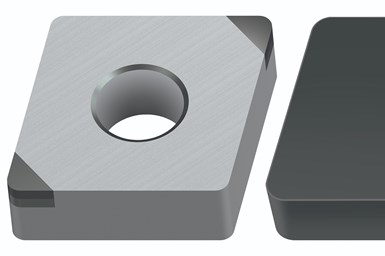New Walter CBN Grades Optimized for Challenging Materials
Walter’s new WBK20 and WBK30 CBN grades have edge-preparation designs that are optimized for applications in cast iron and hardened steel.

Walter has introduced WBK20 and WBK30, new CBN grades with edge-preparation designs optimized for their target applications in cast iron and hardened steel.
With its tipped configuration, WBK20 is wear resistant and well suited for the finishing of cast iron or powered metal workpieces. Because of the higher CBN content, it is also well suited for roughing in hard turning applications.
With its full CBN configuration and high CBN content, WBK30 is designed for heavy depths of cut, as well as roughing in cast irons, powder metals and exceptionally hard and tough applications, such as interrupted cuts or hard turning.
These new grades complement Walter's previously released WBH10C coated CBN, WBH10 CBN and WBH20 CBN grades suitable for high temperature stability in hard metal turning. These inserts also have the option of a chip breaker (TM-M2) for troubleshooting, and wiper (MW2) for quality surface finish, and higher feeds and productivity. Various standard ISO turning insert shapes with these new grades, such as C, D, S and T, are available in both positive and negative clearance geometries. The WBS10 and WBH20 grades are also available as grooving inserts for aerospace alloys and hard steels, respectively.
Related Content
-
Kyocera Turning Grade Provides Tough Cutting Edge
The Megacoat Tough coating combines a wear-resistant layer on the surface adhered to high-content CBN, which provides greater fracture resistance when encountering interruptions.
-
Walter Turning Grades Feature Curved Wiper Cutting Edge
The FW4 and MW4 positive wiper geometries provide a wiper action that can reportedly be used to reduce machining time by using double the feed rate.
-
Finding the Right Tools for a Turning Shop
Xcelicut is a startup shop that has grown thanks to the right machines, cutting tools, grants and other resources.












